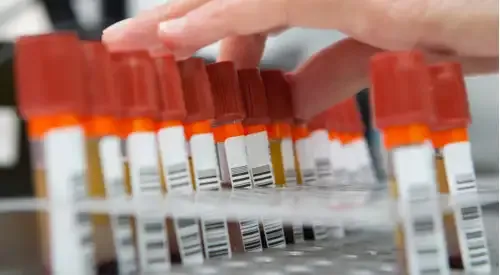Idiopathic thrombocytopenic purpura
"The goal of the therapy is to stop the bleeding and raise the number of platelets above 20,000/mm3".
DR. RAMÓN LECUMBERRI
CODIRECTOR. HEMATOLOGY AND HEMOTHERAPY DEPARTMENT

Thrombocytopenic purpura is a disease characterized by a decrease in platelets.
It is caused by immune organs producing antibodies against platelets, which cause the spleen to recognize the platelets themselves as foreign cells and destroy them.
In children, it appears after a virus infection. Acute ITP is most common in children between the ages of two and nine and usually goes into spontaneous remission.

What are the symptoms of thrombocytopenic purpura?
Patients with thrombocytopenic purpura may remain asymptomatic, or present persistent cutaneous bleeding (especially in areas exposed to trauma) or bleeding from the mucous membranes (epistaxis or nasal bleeding, menorrhagia or vaginal bleeding, ecchymosis). Internal bleeding and hemarthrosis (joint bleeding) are rare.
Most common symptoms:
- Bleeding in the skin and other organs.
Do you have any of these symptoms?
You may suffer from thrombocytopenic purpura
How is purpura diagnosed?

The diagnosis of thrombocytopenic purpura is established through medical history, physical examination and platelet count.
Non-trauma related bleeding usually does not pose a problem as long as the platelet count remains above 20,000/mm.3, but can occur after trauma even with higher platelet counts.
The other usual coagulation studies are usually normal.
How is thrombocytopenic purpura treated?
The treatment is indicated for cases with bleeding due to thrombocytopenia or patients with platelet counts below 20,000/mm3. The aim of therapy is to stop the bleeding and raise the number of platelets above 20,000/mm3.
The treatment consists of:
- Corticosteroids. Prednisone can be used for 63 weeks and provides a success rate of up to 80%.
- Splenectomy (surgical removal of the spleen). Splenectomy is reserved for cases resistant to conservative therapy, it is rare in childhood. It provides a success rate of 60 % to 80 %.
- Immunosuppressive drugs. These drugs are used if the low platelet count persists despite treatment with steroids or splenectomy. The most widely used is rituximab (antiCD-20 antibody). Vincristine is another agent used less frequently.
- Gamma globulins I.V.: Intravenous gamma globulin at a dose of 1g/kg/day for 2 days has been successfully used in cases of refractory ITP and in situations of severe bleeding.
- Other therapeutic options. New thrombopoietic agents have recently been approved, such as Eltrombopag (Revolade®) and Romiplostin (Nplate®). They are now indicated in cases of refractory ITP, as an option even before splenectomy.
Where do we treat it?
IN NAVARRA AND MADRID
The Hematology and Hemotherapy Service of the
at the Clínica Universidad de Navarra
The Hematology Service of the Clinic, formed by specialists of recognized national and international prestige, has integrated molecular diagnostic techniques and the use of new personalized treatments in its assistance work, allowing a more precise and fast diagnosis of the hematological diseases.
The joint work of the medical staff and the researcher facilitates the development and application of the new treatments and at the same time the precise evaluation of the result of the treatments.

Why at the Clinica?
- Experts in the development of Cellular Therapy treatments.
- International reference center in lymphomas, multiple myeloma and monoclonal gammopathies.
- Experts in the diagnosis and treatment of hemorrhagic and thrombotic problems.
Our team of professionals



















